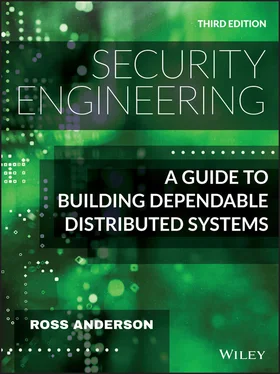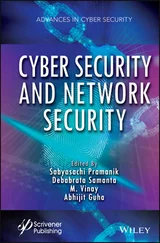The question was raised again in the nineteenth century, when some well-meaning people wanted to ban books on locksmithing. In 1853, a contemporary writer replied [1899]:
‘Many well-meaning persons suppose that the discussion respecting the means for baffling the supposed safety of locks offers a premium for dishonesty, by showing others how to be dishonest. This is a fallacy. Rogues are very keen in their profession, and already know much more than we can teach them respecting their several kinds of roguery. Rogues knew a good deal about lockpicking long before locksmiths discussed it among themselves … if there be harm, it will be much more than counterbalanced by good.’
Thirty years later, in the first book on cryptographic engineering, Auguste Kerckhoffs explained that you must always assume that the other side knows the system, so security must reside in the choice of a key.
His wisdom has been borne out by long experience since. The relative benefits of ‘Open’ versus ‘Closed’ security systems have also been studied by researchers applying the tools of dependability analysis and security economics. We discuss their findings in this book.
In short, while some bad guys will benefit from a book such as this, they mostly know it already – and the good guys benefit much more.
Ross Anderson
Cambridge, November 2020
In a paper he wrote with Roger Needham, Ross Anderson coined the phrase ‘programming Satan's computer’ to describe the problems faced by computer-security engineers. It's the sort of evocative image I've come to expect from Ross, and a phrase I've used ever since.
Programming a computer is straightforward: keep hammering away at the problem until the computer does what it's supposed to do. Large application programs and operating systems are a lot more complicated, but the methodology is basically the same. Writing a reliable computer program is much harder, because the program needs to work even in the face of random errors and mistakes: Murphy's computer, if you will. Significant research has gone into reliable software design, and there are many mission-critical software applications that are designed to withstand Murphy's Law.
Writing a secure computer program is another matter entirely. Security involves making sure things work, not in the presence of random faults, but in the face of an intelligent and malicious adversary trying to ensure that things fail in the worst possible way at the worst possible time … again and again. It truly is programming Satan's computer.
Security engineering is different from any other kind of programming. It's a point I made over and over again: in my own book, Secrets and Lies, in my monthly newsletter Crypto-Gram, and in my other writings. And it's a point Ross makes in every chapter of this book. This is why, if you're doing any security engineering … if you're even thinking of doing any security engineering, you need to read this book. It's the first, and only, end-to-end modern security design and engineering book ever written.
And it comes just in time. You can divide the history of the Internet into three waves. The first wave centered around mainframes and terminals. Computers were expensive and rare. The second wave, from about 1992 until now, centered around personal computers, browsers, and large application programs. And the third, starting now, will see the connection of all sorts of devices that are currently in proprietary networks, standalone, and non-computerized. By 2003, there will be more mobile phones connected to the Internet than computers. Within a few years we'll see many of the world's refrigerators, heart monitors, bus and train ticket dispensers, burglar alarms, and electricity meters talking IP. Personal computers will be a minority player on the Internet.
Security engineering, especially in this third wave, requires you to think differently. You need to figure out not how something works, but how something can be made to not work. You have to imagine an intelligent and malicious adversary inside your system (remember Satan's computer), constantly trying new ways to subvert it. You have to consider all the ways your system can fail, most of them having nothing to do with the design itself. You have to look at everything backwards, upside down, and sideways. You have to think like an alien.
As the late great science fiction editor John W. Campbell, said: “An alien thinks as well as a human, but not like a human.” Computer security is a lot like that. Ross is one of those rare people who can think like an alien, and then explain that thinking to humans. Have fun reading.
Bruce Schneier
January 2001
In the first section of the book, I cover the basics. The first chapter sets out to clarify concepts and terminology by describing the secure distributed systems commonly found in four environments: a bank, an air force base, a hospital, and the home. The second chapter then plunges into the thick of things by describing the threat actors and how they operate. We look at state actors such as the US, Chinese and Russian intelligence communities, about which we now know quite a lot thanks to disclosures by Ed Snowden and others; we describe the cybercrime ecosystem, which we've been studying for some years now; and we also describe non-financial abuses from cyber-bullying and intimate partner abuse up to election manipulation and political radicalisation. This teaches that a wide range of attackers use similar techniques, not just at the technical level but increasingly to deceive and manipulate people.
In the third chapter we therefore turn to psychology. Phishing is a key technique for both online crime and national intelligence gathering; usability failures are exploited all the time, and are really important for safety as well as security. One of the most fruitful areas of security research in recent years has therefore been psychology. Security engineers need to understand how people can be deceived, so we can design systems that make deception harder. We also need to understand how risk perceptions and realities have drifted ever further apart.
The following chapters dig deeper into the technical meat. The fourth chapter is on security protocols, which specify how the players in a system – whether people, computers, phones or other electronic devices – establish and maintain trust. The fifth is on the ‘duct tape’ that underlies most of the protocols and holds distributed systems together: cryptography. This is the art (and science) of codes and ciphers; but it is much more than a clever means for keeping messages secret from an eavesdropper. Nowadays its job is taking trust from where it exists to where it's needed, maintaining the integrity of security contexts, and much more besides.
The sixth chapter is on access control: how can we keep apart the different apps on a phone, or the different virtual machines or containers on a server, and how can we control the data flows we want to permit between them. Sometimes this can be done cleanly, but often it's hard; web browsers deal with JavaScript code from multiple untrustworthy websites, while home assistants have to deal with multiple people.
The next chapter is on distributed systems. Systems that run on multiple devices have to deal with coordination problems such as concurrency control, fault tolerance, and naming. These take on subtle new meanings when systems must be made resilient against malice as well as against accidental failure. Many systems perform poorly or even fail because their designers don't think through these issues.
The final chapter in this part is on economics. Security economics has grown hugely since this book first appeared in 2001 and helped to launch it as a subject. We now know that many security failures are due to perverse incentives rather than to deficient technical protection mechanisms. (Indeed, the former often explain the latter.) The dependability of a system is increasingly an emergent property that depends on the self-interested striving of large numbers of players; in effect it's an equilibrium in a market. Security mechanisms are not just used to keep ‘bad’ people out of ‘good’ systems, but to enable one principal to exert power over another; they are often abused to capture or distort markets. If we want to understand such plays, or to design systems that resist strategic manipulation, we need some game theory and auction theory.
Читать дальше











